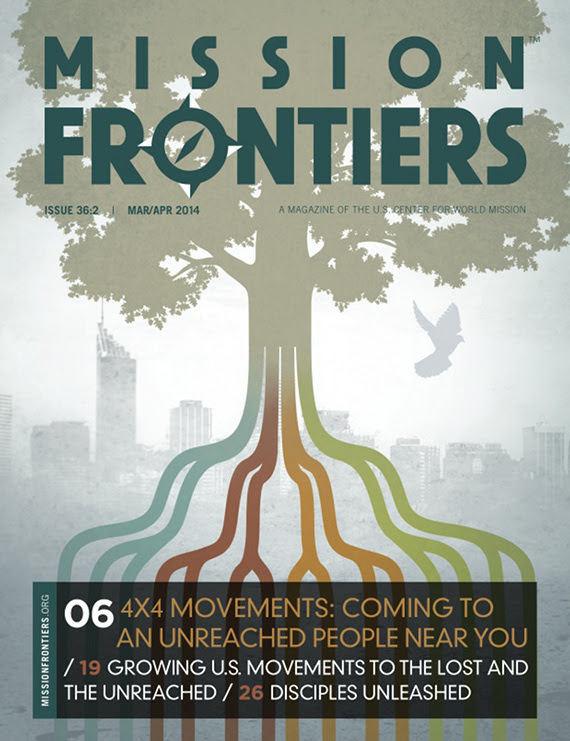Mission Frontiers is has become the leading magazine for great content on disciple-making and church planting movements.
This month’s issue is a must read……
 The March-April issue of Mission Frontiers is now available online. In this issue we are looking at how God uses field workers to pioneer movements among unreached peoples around the world. God is using their expertise in the U.S. in pursuit of similar movements among unreached peoples. These leaders have coined the term 4X4 Movement Starts to describe a minimum goal for movements starts where 4 lineages of disciple-makers are developing 4 more generations of disciples. Read on to find out more. (Full Issue)
The March-April issue of Mission Frontiers is now available online. In this issue we are looking at how God uses field workers to pioneer movements among unreached peoples around the world. God is using their expertise in the U.S. in pursuit of similar movements among unreached peoples. These leaders have coined the term 4X4 Movement Starts to describe a minimum goal for movements starts where 4 lineages of disciple-makers are developing 4 more generations of disciples. Read on to find out more. (Full Issue)
![]() Kindle Download – Read it on any device that uses mobi files (Kindle, Kindle App for iPad/ iPhone/ Mac/ Android)
Kindle Download – Read it on any device that uses mobi files (Kindle, Kindle App for iPad/ iPhone/ Mac/ Android)
Featured Articles
Introducing… 4X4 Movement Starts
Ministries aim to grow wide (a regular audience of many members), but not deep (many generations). Ministries urge: “come to our meeting,” “listen to our message,” “read our materials,” or “visit our site.” Ministries ask members to invite others rather than training them to reproduce. Ministries tend to overextend leaders while leaving disciples dependent and underdeveloped. Movements on the other hand, equip members to obey and teach what they receive, often with little interaction two or more generations away. (full article)
No Longer “Business as usual”
As a family we have witnessed door to door for decades, using whatever model was favored by our current local church. They were always encouraged, and the people to whose homes we went seemed more responsive with someone from out of town. And as we shared the gospel, we joyfully experienced GOD! But after we, with others, helped add 1,200 people to one church, these people eventually wandered away because there was no structure for discipleship and leadership development to equip the fruit of these evangelistic outreaches for multiplication. Now, in the tools that God has given us, we have a reproducing entry strategy, a reproducing gospel which new believers share right away, reproducing discipleship, reproducing gatherings of new believers, and multiplication of leaders. (full article)
I started my ministry as a pastor in 1990 in the usual way of “attractional” church. The traditional idea of “doing church” was to develop a program on Sundays that would draw those who were far from God to hear the Gospel and connect with the Lord and His people. But after more than 20 years doing it this way, something seemed very ineffective to me with this approach. I’ve said for a long time, “I’m way too old to play church!” Furthermore, I realized that in my 22 years as a pastor I had encouraged, challenged, rebuked, motivated, inspired and even scolded Christians toward disciple-making. But I had never taught them how to make a disciple. it had never occurred to me that my first responsibility as a pastor in “equipping the saints for the work of ministry” (Eph 4:11-13 ESV) was to teach them how to make disciples who were abet to make disciples. (2 Tim 2:2) (full article)
No Longer “Discipleship as usual”
By 2010, I had been discipling others for 30 years and risen to national level leadership with the Navigators. Then a speaker introduced me to the book, Movements that Change the World. I was more than curious. This launched me on a three-year study of what God is doing around the world. The final book on my reading list was T4T: A Discipleship Re-revolution by Steve Smith and Ying Kai. As I started reading a voice in my head said, “Humble yourself and do this.” By now I had read hundreds of books on discipleship methods, and I wasn’t about to blindly start doing new stuff. But the Holy Spirit persisted in speaking to me, and I determined to obey. Never have I seen God do so much so quickly, nor to such depth. (full article)
Growing U.S. Movements to the Lost and the Unreached
We started our house church in October 2012. We just called it “porch church” since we started by meeting on our porch. We started with eight folks but only have seven now. We’ve intentionally not added new members but seek to start new churches with new folks. As of December 2013, we have multiple streams to the 5th generation or beyond and well over a dozen more to the 4th generation. All told there are about 200 downstream churches in the USA and 162 overseas, including several among previously unengaged people groups. The total number of new professions of faith is now over 10,500. Our vision is to make it the norm for followers of Christ to become multiplying disciple-makers. (full article)
Fostering Multigenerational Movements by Equipping Believer-Priests
I moved from traditional church ministry to pursuing a generational church movement in January 2005. A desire to reach the lost and an honest look at how the first-century world was discipled in reproducing churches inspired us to “Re-en-ACT” our approach to the Great Commission. As a result we’ve had approximately 1000 generational groups and churches started in our people group. We live outside our people group, but I have personally led two to faith who have started generational church streams. Also, a volunteer team I was with led another person to faith who started a large generational stream. As a result, my primary role shifted from evangelism to training. Discipling these new believers as partner-priests, rather than students, has fostered generational growth. (full article)
In Honduras, Kenya, Guatemala, Israel, Congo, Pakistan, and many other nations, the Body of Christ is stirring in a mighty way, hungry for God’s work. Pastors and church leaders all over the world are hearing the call to return to “the Jesus model” of making disciples. Applying the tools Jesus modeled for us is resulting to impact the world. (full article)
These and other articles are available at missionfrontiers.org. Join the conversation today.





 Today I went to a Celebration of the Life of Lyn Montgomery…who entered eternity earlier this week to join her Lord and her love Jim. I have known Lyn only in these last 4 years, but I know I missed her most fun and fruitful days. The years wore on her beautiful body and soul, yet I long to know the woman that I heard the stories of today…at least to taste her carrot cake!
Today I went to a Celebration of the Life of Lyn Montgomery…who entered eternity earlier this week to join her Lord and her love Jim. I have known Lyn only in these last 4 years, but I know I missed her most fun and fruitful days. The years wore on her beautiful body and soul, yet I long to know the woman that I heard the stories of today…at least to taste her carrot cake! I never had the privilege to know Jim either, as he passed in 2006. Never-the-less, I’ve been deeply impacted by his work, vision and writings. He brought us in the church/missions world the idea, strategy and success of saturation church planting. On his shoulders, the ministry of
I never had the privilege to know Jim either, as he passed in 2006. Never-the-less, I’ve been deeply impacted by his work, vision and writings. He brought us in the church/missions world the idea, strategy and success of saturation church planting. On his shoulders, the ministry of 














 We can learn much by comparing the results of the communist revolution in Russia with that in China. Both were bloody revolutions that attempted militarily to snuff out all opposition, close down all churches, remove all missionaries and incarcerate all of the church leaders.
We can learn much by comparing the results of the communist revolution in Russia with that in China. Both were bloody revolutions that attempted militarily to snuff out all opposition, close down all churches, remove all missionaries and incarcerate all of the church leaders.